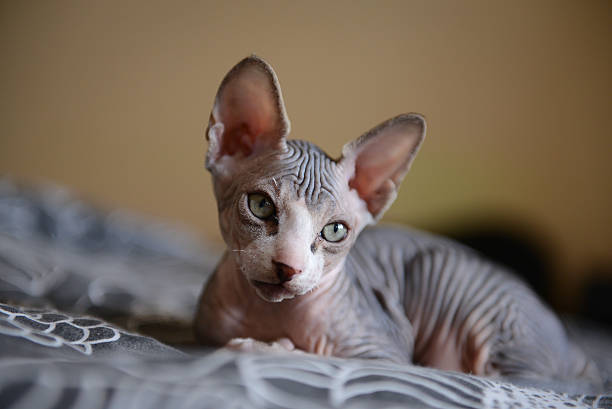Peterbald

History:
The Peterbald is a relatively modern breed that originated in Russia in 1994. It was created by crossing a Don Sphynx (Donskoy) with an Oriental Shorthair, in an effort led by Russian breeder Olga S. Mironova in St. Petersburg. The goal was to combine the elegant structure of Oriental breeds with the hair-losing gene of the Donskoy. The resulting cats had a slender, graceful build and varying degrees of hairlessness. The breed quickly gained popularity in Russia and Europe and was recognised by the International Cat Association (TICA) in 1997. The Peterbald is now known for its affectionate nature, unique appearance, and versatility in coat type, ranging from completely bald to velvety-furred. Despite their delicate look, they are energetic and social companions.
Size: Medium-sized cat
Height: 20–25 cm
Weight: 3–5 kg
Life Expectancy: 12 to 15 years

Breed Appearance:
The Peterbald is a sleek, elegant cat with a slim but muscular body, long legs, and a whippy tail. Its head is wedge-shaped with high cheekbones, a straight profile, and large, flared ears. Almond-shaped eyes—usually green or blue—give an alert and intelligent expression. One of the most distinctive traits of the Peterbald is its coat, or lack thereof. The breed can be completely hairless, velour (short, soft fuzz), brush (coarse, wiry hair), or straight-coated. Some are born with hair that they later lose. Skin is soft, warm, and elastic, often showing visible wrinkles, particularly around the neck and shoulders. Whiskers and eyebrows are usually curled or sparse.
Health & Care:
Peterbalds are generally healthy but require specific care due to their skin type. Hairless and fine-coated individuals can be prone to skin issues such as oil buildup, sunburn, or irritation from rough surfaces. They may also need extra warmth in colder climates. Weekly wiping or occasional bathing helps remove oils and keep the skin clean. Like other Oriental breeds, Peterbalds may be susceptible to dental issues, so regular tooth brushing and veterinary dental care are important. Routine vet visits and a balanced, high-quality diet support their overall health. Despite their fragile appearance, Peterbalds are sturdy and active cats that enjoy regular play and interaction.

Living Conditions:
Peterbalds are highly affectionate and crave attention, thriving in homes where they are not left alone for long. They do best in warm, indoor environments due to their lack of protective fur. These cats are well-suited to apartments or houses, as long as they have soft bedding, cosy nooks, and human companionship. Peterbalds are excellent with children and other pets and are known to follow their owners from room to room. They are intelligent and playful, enjoying puzzle toys and interactive games. Because of their social nature, they can become lonely or depressed if neglected, so they flourish in lively households with plenty of engagement.
Grooming:
Peterbald grooming depends on coat type. Hairless and velour-coated individuals need regular wiping with a damp cloth or occasional baths to manage skin oils, as they do not have fur to absorb it. Brush-coated Peterbalds benefit from gentle brushing a couple of times per week. All Peterbalds should be kept warm in colder months and protected from direct sun exposure to prevent burns. Nail trimming, ear cleaning, and dental care should be done routinely. Their grooming routine is unique but not intensive, and with consistent care, their skin and overall appearance remain healthy and neat.

Advantages:
-
Peterbalds are exceptionally affectionate and loyal, forming deep bonds with their humans and often acting like little shadows.
-
Their unique appearance—sleek build, large ears, and varying coat types—makes them a visually striking breed.
-
They are highly social, intelligent, and playful, often learning tricks or adapting to leash training.
-
Peterbalds are hypoallergenic to some degree, producing fewer allergens than fully-furred breeds, though this varies by individual.
-
They get along well with other cats, dogs, and respectful children, making them versatile family companions.
Disadvantages:
-
Due to their lack of fur, Peterbalds are sensitive to temperature changes and need warm indoor environments.
-
Their skin requires special care to prevent oil buildup and irritation, necessitating regular cleaning or bathing.
-
They are prone to dental issues and require consistent oral care.
-
Peterbalds are very people-oriented and may develop separation anxiety if left alone for extended periods.
-
Because they are a relatively rare breed, Peterbalds can be expensive and hard to find from reputable breeders.

